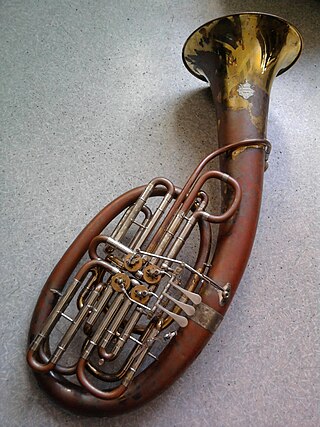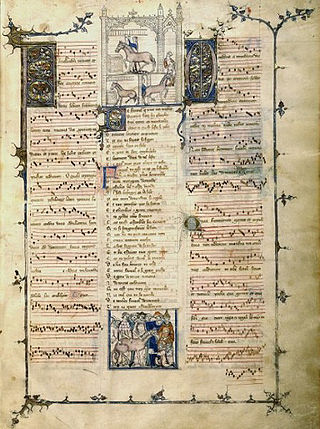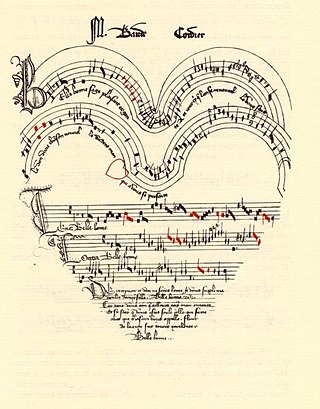Related Research Articles
Plainsong or plainchant is a body of chants used in the liturgies of the Western Church. When referring to the term plainsong, it is those sacred pieces that are composed in Latin text. Plainsong was the exclusive form of Christian church music until the ninth century, and the introduction of polyphony.

The Wagner tuba is a four-valve brass instrument commissioned by and named after Richard Wagner. It combines technical features of both standard tubas and French horns, though despite its name, the Wagner tuba is more similar to the latter, and usually played by horn players. Wagner commissioned the instrument for his four-part opera cycle Der Ring des Nibelungen, where its purpose was to bridge the acoustical and textural gap between the French horn and trombone.
Léonin was the first known significant composer of polyphonic organum. He was probably French, probably lived and worked in Paris at the Notre Dame Cathedral and was the earliest member of the Notre Dame school of polyphony and the ars antiqua style who is known by name. The name Léonin is derived from "Leoninus," which is the Latin diminutive of the name Leo; therefore it is likely that Léonin's given French name was Léo.

Ars nova refers to a musical style which flourished in the Kingdom of France and its surroundings during the Late Middle Ages. More particularly, it refers to the period between the preparation of the Roman de Fauvel (1310s) and the death of composer Guillaume de Machaut in 1377. The term is sometimes used more generally to refer to all European polyphonic music of the fourteenth century. For instance, the term "Italian ars nova" is sometimes used to denote the music of Francesco Landini and his compatriots, although Trecento music is the more common term for the contemporary 14th-century music in Italy. The "ars" in "ars nova" can be read as "technique", or "style". The term was first used in two musical treatises, titled Ars novae musicae by Johannes de Muris, and a collection of writings attributed to Philippe de Vitry often simply called "Ars nova" today. Musicologist Johannes Wolf first applied to the term as description of an entire era in 1904.
Gustave Reese was an American musicologist and teacher. Reese is known mainly for his work on medieval and Renaissance music, particularly with his two publications Music in the Middle Ages (1940) and Music in the Renaissance (1954); these two books remain the standard reference works for these two eras, with complete and precise bibliographical material, allowing for almost every piece of music mentioned to be traced back to a primary source.

Notker the Stammerer, Notker Balbulus, or simply Notker, was a Benedictine monk at the Abbey of Saint Gall active as a composer, poet and scholar. Described as "a significant figure in the Western Church", Notker made substantial contributions to both the music and literature of his time. He is usually credited with two major works of the Carolingian period: the Liber Hymnorum, which includes an important collection of early musical sequences, and an early biography of Charlemagne, the Gesta Karoli Magni. His other works include a biography of Saint Gall known as the Vita Sancti Galli and a martyrology, among others.

Franchinus Gaffurius was an Italian music theorist and composer of the Renaissance. He was an almost exact contemporary of Josquin des Prez and Leonardo da Vinci, both of whom were his personal friends. He was one of the most famous musicians in Italy in the late 15th and early 16th centuries.
Abū Isḥāq Ibrāhīm al-Mawṣilī was an Arab musician of Persian origin who was among the greatest composers of the early Abbasid period. After Arab and Persian musical training in Ray, he was called to the Abbasid capital of Baghdad where he served under three successive Abbasid caliphs: Al-Mahdi, Al-Hadi and Harun al-Rashid. He became particularly close with the latter and emerged as the leading musician of his time. He championed the conservative school of Arab music against progressives such as Ibn Jami. His son and student Ishaq al-Mawsili would succeed him as the leader of the conservative tradition and his other pupils included the musicians Mukhariq, Zalzal and Ziryab. He appears in numerous stories of One Thousand and One Nights.

Baude Cordier was a French composer in the ars subtilior style of late medieval music. Virtually nothing is known of Cordier's life, aside from an inscription on one of his works which indicates he was born in Rheims and had a Master of Arts. Some scholars identify him with Baude Fresnel, a harpist and organist in the court of Philip the Bold, though other scholars have rejected this.
James William McKinnon was an American musicologist most known for his work in the fields of Western plainchant, medieval and renaissance music, Latin liturgy and musical iconography.
Claude Victor Palisca was an American musicologist. An internationally recognized authority on early music, especially opera of the Renaissance and Baroque periods, he was the Henry L. and Lucy G. Moses Professor Emeritus of Music at Yale University. Palisca is best known for co-writing the standard textbook A History of Western Music, as well as for his substantial body of work on the history of music theory in the Renaissance, reflected in his editorship of the Yale Music Theory in Translation series and in the book Humanism in Italian Renaissance Musical Thought (1985). In particular, he was the leading expert on the Florentine Camerata. His 1968 book Baroque Music in the Prentice-Hall history of music series ran to three editions.
Theodore Cyrus Karp was an American musicologist. His principal area of study was Secular music, mainly mediaeval monophony, especially the music of the trouvères. He was a major contributor in this area to the Grove Dictionary of Music and Musicians.
The Plainsong and Medieval Music Society (PMMS), also spelled as the Plainsong and Mediæval Music Society, is an English music society. Founded in 1888, the PMMS primarily researches, promotes and produces publications on medieval music, particularly the liturgical chant from that time to the present. A registered charity since 1987, it has been particularly influential in encouraging the revival of Anglican chant. Musicologists associated with the PMMS include H. B. Briggs, Anselm Hughes, G. H. Palmer, and George Ratcliffe Woodward, and more recently Gustave Reese, D. H. Turner, John Stevens, Christopher Page and Margaret Bent.

Trevor Noël Goodwin was an English music critic, dance critic and author who specialized in classical music and ballet. Described as having a "rare ability to write about music and dance with equal distinction", for 22 years Goodwin was Chief music and dance critic for the Daily Express. He held criticism posts at many English newspapers, including the News Chronicle, Truth and The Manchester Guardian among others; from 1978 to 1998 he also reviewed performances for The Times. Goodwin wrote an early history of the Scottish Ballet and was coauthor for two books: London Symphony: Portrait of an Orchestra with Hubert J. Foss and a Knight at the Opera with Geraint Evans.
References
- 1 2 3 4 —— (2001). "Hiley, David" . Grove Music Online . Oxford: Oxford University Press. doi:10.1093/gmo/9781561592630.article.47773. ISBN 978-1-56159-263-0.(subscription or UK public library membership required)
- ↑ Crocker, Richard (2011). "Gregorian Chant. By David Hiley". Music and Letters . 92 (4): 633–636. doi:10.1093/ml/gcr082. JSTOR 41418777.
- ↑ "David Hiley". Academia Europaea . Retrieved 24 December 2023.